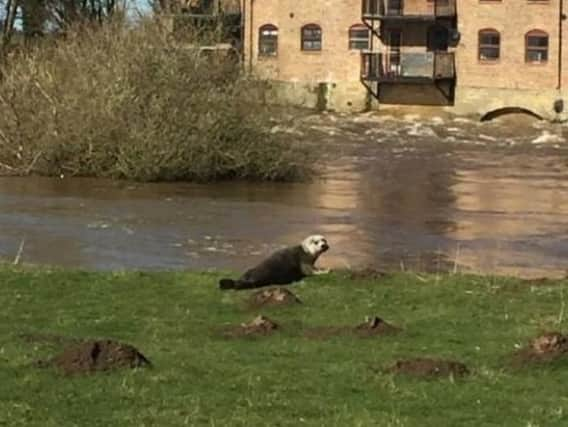Thirsk residents in mourning after seal stranded in Yorkshire river dies during rescue attempt


The common seal first appeared in Topcliffe Weir in April after swimming up the River Swale from the Humber Estuary during winter flooding - a distance of over 90 miles.
It became a much-loved character and was nicknamed Sammy by locals - although online threats against its safety were also made over fears it could damage the ecosystem in the weir pool, which is a popular angling spot.
Advertisement
Hide AdAdvertisement
Hide AdRescue charity British Divers Marine Life Rescue first tried to capture the seal using a specially-constructed net a week after the first sighting, but were unsuccessful and several subsequent efforts also failed. The animal was finally caught on August 10, but stopped breathing and died during the rescue.
The volunteers had planned to return it to the North Sea, as seals cannot gain the nutrition they require from a freshwater diet. A post-mortem revealed the adult male was underweight when it died.
A statement from the charity read:
"Over the last four months, British Divers Marine Life Rescue have been working in close conjunction with the Angling Trust, Environment Agency, Marine Management Organisation, Natural England, York Rescue Boat and local police officers to capture an adult common seal that had become confined to a section of the River Swale near Topcliffe. It was thought the animal initially arrived here after severe flooding in the area earlier this year while swimming up the River Humber, and once the floodwaters receded had been unable to find its way back out to sea again.
"Several attempts have been made to capture the seal during this time by the local BDMLR volunteer team with support from the other organisations involved, with specialist equipment such as a large funnel net being constructed especially for the task. As a typically cautious wild animal, the seal managed to evade capture on these occasions, either by dodging the equipment or hiding in areas that were difficult to access and work in safely.
Advertisement
Hide AdAdvertisement
Hide Ad"Early on the morning of Friday 10 August, the team managed to corner the seal at the weir at Topcliffe and were able to capture it in the net. It was brought ashore and was in the process of being transferred to a transport crate when it suddenly stopped breathing without warning. Despite resuscitation attempts being made, the seal sadly could not be revived.
"Needless to say, the entire team and our partner organisations that had tried so hard for so long to rescue this animal are devastated by the outcome and are deeply affected by the events that transpired. A post-mortem examination has already been arranged to investigate further what may have caused this to happen, though it has been noted already by veterinary experts that the animal appeared to be underweight for its size, which could have been a contributing factor.
"BDMLR would like to express its sincere gratitude to our partner organisations, particularly the Angling Trust, who provided a great deal of support throughout this complex incident, as well as the many local residents and fishermen who were looking out for this animal, providing information and offering assistance to us. We have all learned a lot from the experience that we can take forward with similar incidents elsewhere in the country for the future."
Anglers reported that fish stocks in the river had depleted during the residence of the 'Seal of the Swale', while hundreds of onlookers turned out to watch the rescue attempts.
Advertisement
Hide AdAdvertisement
Hide AdTopcliffe Weir's community Facebook page also posted a tribute to the animal:
"A lot of people spent a lot of time trying to rescue this poor seal. We all wanted the same ending. Unfortunately we didn't get the outcome we wanted. We would like to thank the BDMLR, the local anglers and other local people involved who have attempted to rescue the seal. Everyone involved has volunteered their own free time to try to return the seal to his natural habitat. We watched the rescue and it was done professionally and quickly. He will be missed."
Seals are known to follow shoals from the tidal Humber all the way to the Ouse and the Wharfe, but they usually get no further than the weirs at Naburn and Tadcaster.